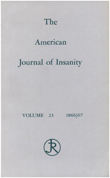Criterion and predictive validity of the diagnosis of adjustment disorder: a prospective study of youths with new-onset insulin- dependent diabetes mellitus
Abstract
OBJECTIVE: The authors examined the criterion and predictive validity of the diagnosis of adjustment disorder in a pediatric study group. METHOD: Ninety-two school-age children with new-onset insulin-dependent diabetes mellitus were evaluated repeatedly and were diagnosed by using DSM-III. The criteria for adjustment disorder were further operationalized by requiring four clinically significant symptoms or signs; the time frame for its onset was extended to 6 months after the diagnosis of insulin-dependent diabetes. Predictive validity was assessed in terms of new psychiatric disorders other than adjustment disorder during the next 5 years. RESULTS: Of the 92 children, 33 developed adjustment disorder and five developed other psychiatric disorders in response to the diagnosis of insulin-dependent diabetes mellitus. Mean time from diabetes diagnosis to onset of adjustment disorder was 29 days, the average episode length was 3 months, and the recovery rate was 100%. Among youths with adjustment disorder in response to the medical diagnosis, the 5-year cumulative probability of a new psychiatric disorder was 0.48, compared to 0.16 among the other youths. CONCLUSIONS: The findings generally support the criterion validity of the diagnosis of adjustment disorder. However, episode duration and the predictive validity of the diagnosis appear to be functions of the study group being examined. In nonpsychiatrically referred pediatric patients, early problems in adaptation to the stress of changed health status, as evidenced by adjustment disorder, appear to signal vulnerability to later psychopathology.
Access content
To read the fulltext, please use one of the options below to sign in or purchase access.- Personal login
- Institutional Login
- Sign in via OpenAthens
- Register for access
-
Please login/register if you wish to pair your device and check access availability.
Not a subscriber?
PsychiatryOnline subscription options offer access to the DSM-5 library, books, journals, CME, and patient resources. This all-in-one virtual library provides psychiatrists and mental health professionals with key resources for diagnosis, treatment, research, and professional development.
Need more help? PsychiatryOnline Customer Service may be reached by emailing [email protected] or by calling 800-368-5777 (in the U.S.) or 703-907-7322 (outside the U.S.).



